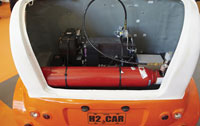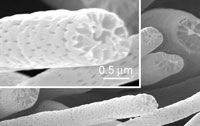Hydrogen’s physical characteristics make it difficult to store in large quantities without taking up a significant amount of space. It has a very high energy content by weight – about three times more than gasoline – but it has a very low energy content by volume – liquid hydrogen is about four times less energy dense than gasoline.
Much of the ongoing research into hydrogen storage is focused on meeting needs for vehicles. The US Department of Energy (DoE) has clear targets to ensure that hydrogen-powered vehicles are competitive with conventional vehicles.1 The overall objective is that they must be able to travel more than 300 miles on one tank and be refilled within three minutes.
Hydrogen storage
Hydrogen can be stored as compressed gas at pressures up to 700bar (10,000psi). But the high-pressure tanks required for these pressures are heavy and expensive. It can also be stored as liquid hydrogen – cooled to –253°C, at pressures of 6–350bar – but the insulated tanks have to be specially designed and shaped.
Both methods require large amounts of energy and present safety risks. They also fall short of DoE targets in the categories of cost, ‘gravimetric hydrogen density’ – the potential energy in a given weight of fuel – and ‘volumetric hydrogen density’, the potential energy in a given volume of fuel, explains a DoE spokesperson. The DoE’s 2015 target densities are 5.5% hydrogen by weight and 40g hydrogen/L system.2,3 While the DoE expects continued progress in reducing costs and some improvements in storage capacity, it is clear that these methods will never meet all targets.
Hydrogen can also be stored within a material’s structure or on its surface; or in chemical compounds that undergo a chemical reaction to release hydrogen. Areas of study include metal and complex hydrides; and carbonbased materials and high-surface area structures, including carbon nanotubes and nanofibres, metal–organic frameworks and conducting polymers.
'For all of these, there is a trade-off between weight, hydrogen storage potential, ability to release the hydrogen readily, and temperature and/or pressure,' says Karen Hall of consultancy Technology Transition. 'The goal of much of the research is to reach the DoE targets, but none of the technologies currently meet all the goals. Each type of technology struggles with a specific trade-off.'
Metal hydride technology
Metal hydride technology uses metals and metal alloys to adsorb hydrogen under moderate pressure and temperature, creating hydrides. The application of heat then releases hydrogen. But metal hydrides that can store high capacities of hydrogen require high temperatures (300–350°C) to release hydrogen. Some metal hydrides, such as LaNi5H6, which can operate at lower temperatures, lose their high storage capacities. Others, such as alanate (AlH4), store and release hydrogen reversibly when catalysed with titanium dopants.

Nevertheless, many research groups are working with metal hydrides. A US team at the University of Hawaii, in collaboration with the Sandia and Pacific Northwest National Laboratories, has recently made an interesting advance. The team has shown that magnesium borohydride (Mg(BH4)2) can release, and be recharged with, over 12% hydrogen by weight.4 'This is exciting,’ says the DoE spokesperson, ‘because it is the highest demonstrated reversible gravimetric capacity. It indicates there are potential pathways for high capacity materials to be reversibly charged/discharged.’
In another approach, hydrogen is generated through a chemical reaction, often involving metal hydrides with water or alcohols. Sodium borohydride is one the most studied examples:
NaBH4 + 2H2O + NaBO2 + 4H2
While researchers have reported hydrogen capacities around 4%wt, the borohydride cannot be regenerated onboard a vehicle and the vehicle must carry water.
Also under investigation is the reaction MgH2 with water to form Mg(OH)2and H2. Capacities can reach as high as 11%wt, but again water must be carried onboard, and regeneration must be done off-board.
Hydrogenation and dehydrogenation reactions also show promise for hydrogen storage. For example, the decalin-to-naphthalene reaction can release 7.3%wt at 210°C using a platinumbased or noble-metal-supported catalyst:
C10H18 + C10H8 + 5H2
‘Chemical hydrogen storage can have high gravimetric densities up to about 20%wt, and release rates can be achieved within the operating temperature range of PEM fuel cells,’ says the DoE spokesperson. ‘But the disadvantages include low efficiencies for regenerating the spent material back to the hydrogenated form; and the need to include a solvent or only partially dehydrogenate the material so that it remains in a liquid form. Also many materials, such as sodium borohydride, release hydrogen through an exothermic reaction and so strategies are required to control the hydrogen release to prevent unintended release.’
Another chemical approach involves hydrogen generation from ammonia–borane materials. The first reaction, which occurs at less than 120°C, releases 6%wt H2, while the second reaction, which occurs around 160ºC, releases 6.5%wt.
NH3BH3 + NH2BH2 + H2 + NHBH + H2
‘Ammonia borane is a promising hydrogen storage material, but it was once thought that it could not be conveniently and efficiently regenerated from the spent material,’ explains the DoE spokesperson. But now US researchers at Los Alamos National Laboratory and the University of Alabama have demonstrated a simple one-pot regeneration process for several forms of spent ammonia borane.5 ‘The well-to-wheel efficiency is still relatively low, but it is due to current low efficiency processes for producing the reactant used in the regeneration and this can be worked on.’
Hydrogen sorbents
Another promising research area is based on microporous metal–organic frameworks (MOFs). These crystalline frameworks consist of metal ions (or clusters) and organic ligands. MOFs can be thought of as a three-dimensional grid in which the vertices are metal ions or clusters of metal ions that are connected to each other by organic molecules. Hydrogen molecules are stored in a MOF by adsorbing to its surface. Several classes of MOFs have been explored, including carboxylate-based MOFs and metal cyanide MOFs. The most common transition metals employed in carboxylatebased frameworks are Cu2+ or Zn2+. Lighter main group metal ions have also been explored such as Be. Some MOFs, such as Zn4O(BTB)2, where BTB3- = 1,3,5-benzenetribenzoate (MOF-177), have larger pores, so hydrogen is compressed within holes rather than adsorbed to the surface Hydrogen is adsorbed at room temperature at around 1%wt, but at 78K (–195°C), capacities have been reported as high as 4%wt, says the DoE spokesperson. ‘The advantages for sorbents are that they can charge/discharge rapidly and require relatively low temperatures to charge up,’ he explains. However, owing to the highly porous nature of these materials, volumetric capacity may still be a significant issue.
More recently, US researchers led by Hong-Cai Zhou of Texas A&M University6 have synthesised frameworks made purely from organics. ‘This is exciting in that the validated gravimetric capacity is the first to break the ~7%wt that has been the record for several years, plus the materials are air and water stable, another improvement over previous promising materials,’ says the DoE spokesperson.
Duncan Gregory and his team at Glasgow University, UK, are taking yet another approach.7 Gregory explains: ‘The problem with metal hydrides is that they hold on to hydrogen too well and need more heat to release it. The problem with porous materials is that they release hydrogen too easily and need cooling down to retain it. We are working somewhere in between trying to combine the best of both worlds.’ Using their own patented nanotechnological methods, the team grows nanofibres and nanowires from undisclosed complex hydrides. 'We have some control over size and shape of the structures so we can test which is the best for hydrogen storage and release.' Research is still at a fundamental stage, but early indications are promising. ‘We have evidence that we can improve the kinetics of hydrogen uptake and release by four fold or more over equivalent bulk materials so that (de)hydrogenation processes takes seconds rather than minutes or hours.’
Future outlook
Some materials have already made it into commercial storage systems for applications such as low-power, portable fuel cell systems. For example, Jadoo Power and Texaco Ovonic Hydrogen Systems (TOHS) have reversible metal hydride-based systems available. Trulite has a sodium borohydride-based system and SiGNa Chemistry, a sodium silicidebased system; in both the hydrogen is released through an hydrolysis reaction. In automotive applications, TOHS, has been used on a prototype system for a Toyota Prius modified to burn hydrogen.
However, for automotive applications, materials-based storage technologies are still too immature to be viable compared with the mature physical storage options, remarks the DoE spokesperson. But there is still ‘tremendous interest in developing materials storage options and considerable progress has been made.’ To be considered for vehicles, any technology would need to achieve the storage goals at something close to ambient temperature, and this has not happened yet, comments Hall. However, novel hydrogen storage materials may be rolled out for other applications, such as portable electronics.
‘There are lots of potential solutions out there, but none that has the complete answer yet,’ says Gregory. ‘It might take 10 years before we have a material that does it all, or we could have a breakthrough tomorrow that would change the approach to hydrogen storage dramatically.’
Hydrides get the nanotechnology treatment for hydrogen storage applications
A UK start-up company claims its novel technology will produce effective and promising hydrogen storage materials, which will compete with gasoline on cost, safety and efficiency. Cella Energy uses a proprietary technology developed by Stephen Bennington and Arthur Lovell at Rutherford Appleton Laboratory and University College, London. This modified electrospinning process traps a complex hydride inside a nano-porous polymer to create a fine micro-fibrous polymer mat, which resembles white tissue paper, or a fine polymer powder of microbeads, with the hydride material ibeing entrained in 50–200nm pores within the polymer. Specialist UK chemical company Thomas Swan, a majority investor in Cella, has helped in scaling up the technology.

The team is currently, materials. ‘We have found that they can release 6% hydrogen by weight and at a relatively low temperature of 85°C, compared with 300°C,’ explains Voller. ‘The gas is released very rapidly over minutes and any release of impurities is significantly suppressed.’
Voller claims that nobody else is using a nanotechnology approach to produce materials in this way. ‘The micro-bead format is particularly interesting as it has properties akin to a liquid fuel that could be used in vehicles just like gasoline, but without any carbon emissions. [The materials] require no additional infrastructure as vehicles can be refilled just like today. And they are safer to handle than gasoline. Prices should be the same as gasoline now stands with oil at more than $100/barrel. If oil gets more expensive, then Cella’s product would be cheaper than gasoline.’
Cella plans to roll out its fuels in two stages. ‘We are now in a proof-ofconcept stage,’ says Voller, ‘working with automotive companies to test our product as a fuel additive and in purehydrogen vehicles. This will take 12–18 months to complete. The second stage of field trials will follow, probably in Germany or Scandinavia.’
Maria Burke is a freelance science writer based in London, UK.
References
1.http://www1.eere.energy.gov/hydrogenandfuelcells/ storage/current_technology.html
2.http://www1.eere.energy.gov/hydrogenandfuelcells/ pdfs/compressedtank_storage.pdf
3.http://hydrogen.energy.gov/pdfs/9017_storage_ performance.pdf
4. Jensen, C. M., et al, Chem. Comm., 2011, 47, (4), 1330
5. Sutton, A. D. And Gordon, J. C., Science, 2011, 331, (6023), 1426; doi:10.1126/science.1199003




